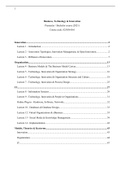1
Business, Technology & Innovation
Premaster / Bachelor course (2021)
Course code: 825036-B-6
Innovation.......................................................................................................................................2
Lecture 1 – Introduction...............................................................................................................2
Lecture 2 – Innovation Typologies, Innovation Management, & Open Innovation....................2
Lecture 3 - Diffusion of Innovation.............................................................................................7
Organization.................................................................................................................................13
Lecture 4 - Business Models & The Business Model Canvas...................................................13
Lecture 5 - Technology, Innovation & Organization Strategy..................................................16
Lecture 6 - Technology, Innovation & Organization Structure and Culture.............................18
Lecture 7 - Technology, Innovation & Process Design.............................................................25
IT...................................................................................................................................................27
Lecture 8 - Information Systems................................................................................................29
Lecture 9 - Technology, Innovation & People in Organizations...............................................31
Online Plug-in - Hardware, Software, Networks.......................................................................32
Lecture 10 - Databases & Database Design...............................................................................33
Lecture 12: Virtual Organizations & eBusiness........................................................................35
Lecture 13 - Social Media & Knowledge Management............................................................39
Lecture 14 - Implementation......................................................................................................42
Models, Theories & Keyterms....................................................................................................43
Innovation..................................................................................................................................43
Organization...............................................................................................................................44
IT................................................................................................................................................47
,2
Innovation
Lecture 1 – Introduction
BTI will help you make informed decisions on the use and effects of IT in an organization. What
factors contribute to an innovation? Innovation is all around us, our everyday world has changed
considerably.
Creativity is the ability to combine ideas to produce something new & useful. Creativity itself
does not start a business: persistent determination to overcome endless design challenges, secure
finances, succession of incremental improvements, manage staff to encourage a flow of creative
ideas (Dyson, Boddy chapter 13). It is a combination of the following factors:
1) Intellectual abilities: seeing problems in new ways
2) Knowledge
3) Style of thinking
4) Personality
5) Motivation
6) Environment
a. Stimulants: organization encouragement, supervisory encouragement, work group
support, sufficient resources, challenging work & freedom.
b. Obstacles: organization impediments/restrictions & workload pressure.
Lecture 2 – Innovation Typologies, Innovation Management, & Open Innovation
Innovation = something that sells VS invention = creating of a thing or ability. Innovation
is about the business impact you do something with the invention. Using the invention to
create impact.
Invention + market entry (impact) = innovation creating value.
The market entry is crucial, especially the response on the market entry. If there is no response, it
will stay an invention. Innovative ideas only add value when people implement them. Innovation
focusses on customer experience. It does not necessarily have to be a big visible breakthrough, a
flow of incremental improvements can be just as useful
the process of applying or implementing something new and useful.
,3
The invention must be iterative; this means that you can build forward on it you can
develop it further
Innovation is often spurred by technology but the term innovation itself is more than technology,
it can be one of these areas:
1) Product (or service) innovation: new product, same market. The innovation brings
incremental or disruptive advantage. For example, a new concept or new technology.
Requires 1000/100/10/1 funnel process
2) Process: internal organization or something that impacts the internal organization (e.g.
starting with delivery, like supermarkets)
3) Positioning: same product but new market
4) Paradigm of the business: changes the entire strategy. The whole idea of what you are
doing changes it disrupts the market.
The impact of an innovation gets bigger if areas of innovations are combined. There are also
important distinguishing between effects on markets and effects on technology or systems of
production. A given innovation may affect the two domains in quite different ways.
Sources of innovations: accidents & the unexpected, knowledge (internal source) and market
(external source).
Innovation and technology can affect the organization but the other way around organizations
can also affect the efficient and effective use of technology. Organizational factors can also
affect innovation (structural, cultural & HRM) itself. Innovations may completely change the
way organization’s function. When thinking of new technology or other innovations, you should
always take the characteristics of the organization into account. There is always interplay
between innovation, IT and organization.
, 4
Closed innovation: the traditional method – a filter through which people gather, channel, and
focus ideas before selecting those with most potential. Sources are internal
Open innovation: Open innovation can work both ways, as companies transfer their technologies
and knowledge to other firms through licensing or joint ventures. Sources are everywhere.
Crowdfunding can also be part of this: asking public to contribute to innovation. There are
different types of crowdfunding:
Knowledge discovery & management
Broadcast search
Peer-vetted creative production (e.g. asking audience to come up with new chips flavor)
Distributed human intelligence tasking: help a computer to process data (e.g. point out all
threes on the picture). This is used to train algorithms.
A transilience map provides a framework that shows relationships among innovation,
competition, and evolution. identifying the role of competition in innovation.
Innovation Process
Almost always innovation is a group process either inside or outside the organization. The
capability of the organization to innovate depends on the characteristics of the innovation.





